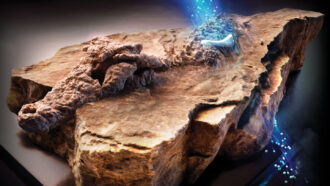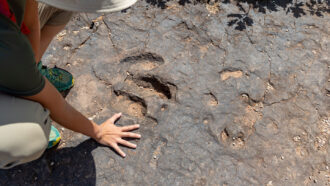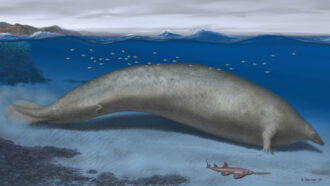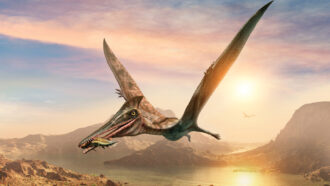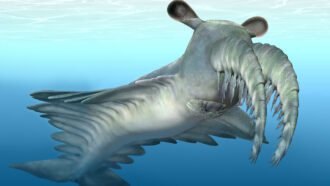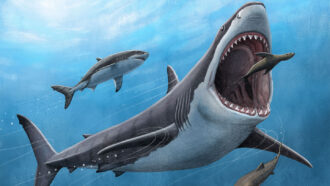Baby titanosaur was a mini version of its parents
Hatchlings may have been active and independent animals
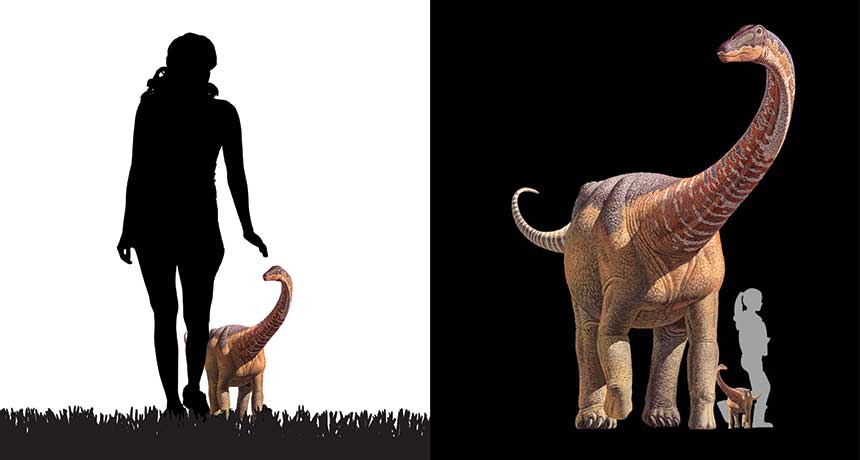
Just weeks after birth, Rapetosaurus krausei, a species of titanosaur, was about the size of a dog (left). The baby dino had similar proportions to an adult of its species (right). That suggests the youngsters didn’t require much parental care.
R. MARTIN AND K. CURRY ROGERS
By Meghan Rosen
Titanosaurs were plant-eating dinos of titanic size. The largest known individual belonging to the species Rapetosaurus krausei would have shook the ground with its epic 16,700 kilogram (36,800 pound) heft. A baby dino would have looked a lot like its grown-ups, a new study shows. And it probably acted like them, too.
Scientists discovered (relatively) tiny fossils of a roughly 1- to 2-month-old R. krausei in Madagascar. Its bones now suggest that babies and adults had similar limb proportions. That’s a sign that the very young were more mature than would be expected. If true, they probably didn’t require much parental care, says Kristi Curry Rogers, who led the new study. A vertebrate paleontologist, she works at Macalester College in St. Paul, Minn.
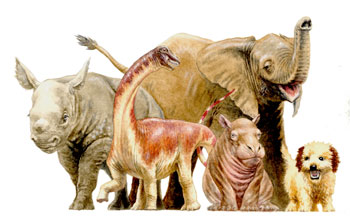
Most titanosaur fossils come from adults. A lack of very young specimens has made it tough to know what the dinosaurs’ growth patterns might have looked like. Curry Rogers and her colleagues now estimate that when newly hatched, the baby would have weighed about 3.4 kilograms (7.5 pounds). That’s about the weight of a newborn human. But in a few short weeks, its weight shot up to 40 kilograms (88 pounds). That’s roughly as heavy as a 12-year-old boy. The dinosaur in the study was about this size when it died, probably from starvation.
The researchers examined the baby dinosaur’s bones with microscopes and CT scans. (CT is short for computerized axial tomography, which uses X-rays to image features of internal bones and other organs.) During the dino’s early growth spurt, all of its limbs grew at about the same rate, the researchers now calculate. Those data plus features of the bones point toward a life that was both active and independent.
Power Words
(for more about Power Words, click here)
computerized axial tomography (CAT or CT, for short). A special kind of X-ray scanning technology that produces cross-sectional views of the inside of a bone or body.
dinosaur A term that means terrible lizard. These ancient reptiles lived from about 250 million years ago to roughly 65 million years ago. All descended from egg-laying reptiles known as archosaurs. Their descendants eventually split into two lines. They are distinguished by their hips. The lizard-hipped line became saurichians, such as two-footed theropods like T. rex and the lumbering four-footed Apatosaurus (once known as brontosaurus). A second line of so-called bird-hipped, or ornithischian dinosaurs, led to a widely differing group of animals that included the stegosaurs and duckbilled dinosaurs.
fossil Any preserved remains or traces of ancient life. There are many different types of fossils: The bones and other body parts of dinosaurs are called “body fossils.” Things like footprints are called “trace fossils.” Even specimens of dinosaur poop are fossils. The process of forming fossils is called fossilization.
limb (in physiology) An arm or leg. (in botany) A large structural part of a tree that branches out from the trunk.
microscope An instrument used to view objects, like bacteria, or the single cells of plants or animals, that are too small to be visible to the unaided eye.
paleontology The branch of science concerned with ancient, fossilized animals and plants. The scientists who study them are known as paleontologists.
species A group of similar organisms capable of producing offspring that can survive and reproduce.
titanosaur A group of dinosaurs with long necks and whiplike tails that ate plants. Named for Titanosaurus, they were noted for their large size.
vertebrate The group of animals with a brain, two eyes, and a stiff nerve cord or backbone running down the back. This group includes amphibians, reptiles, birds, mammals and most fish.
X-ray A type of radiation analogous to gamma rays, but of somewhat lower energy.


